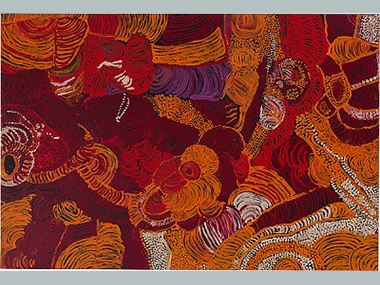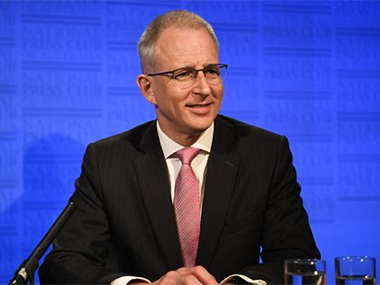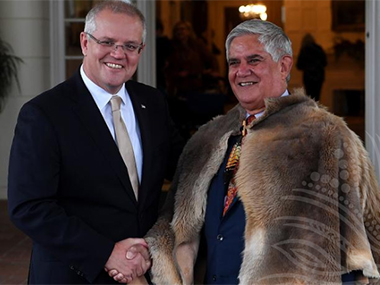Consulting the Industry

'Piltati Tjukurpa' (2006) by the late Kunmanara Stevens, chosen as the backdrop for the Federal Ministers' announcement today
Jeremy Eccles | 02.09.20
Author: Jeremy Eccles
News source: Press Release
The Ministers for the Arts and Indigenous Australians this morning jointly announced that they will develop an Indigenous VisuaI Art Action Plan to support Aboriginal and Torres Strait Islander artists, and their cultural and economic interests.
Yet more consultation, you may think, as has become the name of the game following the Government's continuing failure to Close the Gap – though, sadly, one part of the Mob immediately declared that the wrong people had been consulted! And then there's the tired old reiteration of suggestions such as a certification trademark scheme – which consumed millions way back when and achieved absolutely nothing. And, talking of money, more for the impotent Indigenous Art Code which has been calling for the imposition of mandatory status for the Code years but has been denied.
But in a world where imaginary numbers like $200m a year for the industry have all-too-often been bruited about, some interesting statistics are confidently offered to justify this Action Plan. And their accuracy is confirmed by a Desart report on the post-COVID situation for art centres based on the five-year-old SAM operational database.
And all of you are encouraged to contribute to the consultation. See below.
Here's the gist of the Ministers' announcement – which may (or may not) have happened at the National Gallery in the presence of a Kunmanara Stevens painting so vibrant and confident in its brushstrokes that it, alone, surely justifies the fullest recognition of the primacy of our First Nations artists:
“The Australian Government recognises that Indigenous art is important to Australia and Australians. It sustains and strengthens Indigenous communities, is a vital part of Australia’s identity, and provides opportunities for employment, skills development, and income. Indigenous art also makes a large contribution to the economy.
In 2018–19, organisations supported by the Australian Government’s Indigenous Visual Arts Industry Support (IVAIS) $21m program participated in over 900 exhibitions and events, achieving $26.5 million in primary art sales. It is estimated that each year these activities contribute approximately $70 million to the Australian economy. In addition, in 2018–19, the four Indigenous art fairs supported through the IVAIS program hosted 96,402 visitors, achieved $4.3 million in art sales, and featured work by 2715 artists. Australia’s Indigenous tourism has an estimated value of $5.8 billion annually, catering to 910,000 international visitors and 688,000 overnight domestic trips in 2016.
Of course, visitation has stopped dead under COVID for very valid health reasons, and the online alternative has not taken up the slack. The Desart report, 'Art Centres and COVID-19, July 2020', using data collected between March and June 30th from 84 community art centres, shows a depressing 46% fall in artworks sold compared to 2019, and a 60% fall in artworks produced by 31% fewer artists, though sales income fell by only 30%. That reduced art centre incomes from $10.5m to $7.3m during the lockdown. Interestingly, Queensland has suffered much less than the NT - the extremes of the survey - losing only 10% of artists and less than 50% of artworks produced. WA was marginally better in the artworks produced stakes - suggesting that the ending of their lockdowns was a beneficial factor. By comparison, the NT has lost 67% of its artworks and more than 50% of its sales.
Until the start of COVID-19, art centre sales had been growing for almost a decade. Between 2011–12 and 2018–19, the average sales of art centres have grown by 53.4 per cent. This is still 11.7 per cent lower than at the market’s peak in 2007-08, before the Global Financial Crisis, which caused a drop in sales of work by Indigenous artists. But today art centres are more financially independent, and the proportion of income from grants has fallen to its lowest level for over a decade - at (only) around 40 per cent of total average income.
Aboriginal and Torres Strait Islander artists are investing money earnt through art back into their communities. Artists and art centres are now essential contributors to important social and health initiatives on Country, strengthening community outcomes and investing in their communities’ futures.
One of the Australian Government’s priorities is to support the Indigenous arts industry to grow, to deliver economic opportunities for Aboriginal and Torres Strait Islander artists and to promote ethical dealing.
The IVAIS program provides approximately $21 million per annum to around 80 Indigenous-owned art centres, as well as a number of art fairs, regional hubs and industry service organisations. This provides opportunities for approximately 8,000 Aboriginal and Torres Strait Islander artists and more than 500 Aboriginal and Torres Strait Islander arts workers. The COVID crisis has resulted in extra art funding of $40,000 per art centre, except on the Torres Strait where, mysteriously, only $25,000 was provided.
Further, the Indigenous Languages and Arts (ILA) program invests around $20 million per year to support Aboriginal and Torres Strait Islander peoples to express, preserve and maintain their cultures through languages and arts activities around Australia. The ILA program includes operational funding support to 21 Indigenous Language Centres across the country working to capture, preserve and maintain over 150 Aboriginal and Torres Strait Islander languages.
Even before consultation, the Government is now making the following commitments, which will be incorporated in the Indigenous Visual Art Action Plan:
• That the Productivity Commission will commission a study into the nature and structure of the Indigenous market and policies to address deficiencies in the market
• Additional funding to the Indigenous Art Code from 2019–20 by both the Federal Government and the states and territories, to support the Code’s ongoing work
• Opportunities for targeted support for art centres will be considered under the National Indigenous Australians Agency’s Indigenous Business Sector Strategy
• Tourism Australia will disseminate information to international tourists and the Australian Competition and Consumer Commission will update education for consumers and undertake compliance initiatives with wholesalers and retailers
• IP Australia will continue to work with Indigenous communities to consider the viability of a certification trade mark (CTM) for authentic products
• A trial of digital labels for authentic Indigenous products has been funded by the Australian Government. Desart is running the trial in consultation with three remote art centres, and,
•An assessment of the scope and feasibility of new stand-alone legislation protecting Indigenous Cultural Intellectual Property will be undertaken, including consultation with Indigenous communities.
What do you think?
1. What practical actions do you think will assist to rebuild the market in a sustainable way?
2. What do you like or dislike about how the market currently works?
3. What questions would you like answered in the Productivity Commission study?
4. Different words have different meanings for different people. Should we use ‘Aboriginal and Torres Strait Islander people’ or ‘First Nations people’ in the Action Plan?
5. What do you understand ‘authentic Indigenous art’ to mean? What type of artwork should be included in this definition?
6. What skills do you think are important in the industry? What ways do you build those skills? What would help you to build those skills?
7. Do you get the support and materials you need from your art centre?
8. Is there more that can be done to encourage the development of Indigenous-owned and operated businesses in the industry?
9. What can be done to assist artists to better connect with the art market?
10. How can digital technologies overcome the challenges of remote locations?
11. How significant has selling artwork online been for your art centre through COVID-19? How could you improve how your art centre sells work online?
12. Is there more that needs to be done to engage with the international arts market as well as tourists in Australia?
13. If overseas activities were to be supported, would this assist in engaging in the international market and do you consider this should be a priority
14. Is the current framework protecting Indigenous cultural expressions good enough?
15. Should there be a mandatory Indigenous Art Code? If so, how do you think that should work?
16. Do you like the idea of a certification trademark scheme for authentic products? How do you think it should work?
17. Do you like the way the Resale Royalty Scheme works?
18. Is there more that could be done to increase awareness of moral, cultural and intellectual property rights?
19. How do you think that Indigenous Cultural Intellectual Property protections could work in practical terms?
Answers before 18th December.
Any questions for the authors? Write to:
Visual Arts and Design Section
Office of the Arts
GPO Box 2154
CANBERRA ACT 2601 or
Email:IVA@arts.gov.au
URL: https://www.arts.gov.au/have-your-say/consultation-paper-growing-indigenous-visual-arts-industry
Share this:
»  del.icio.us
»
del.icio.us
»  Digg it
»
Digg it
»  reddit
»
reddit
»  Google
»
Google
»  StumbleUpon
»
StumbleUpon
»  Technorati
»
Technorati
»  Facebook
Facebook
Contact Details

The Communications, Cyber Safety and Arts Minister, Paul Fletcher

Ken Wyatt taking on his responsibiltiies as Minister for Indigenous Australians at the PM's invitation
Further Research
Artists: Kunmanara Stevens
News Tags: Aboriginal art centres | First Nations art | Indigenous VisuaI Art Action Plan | IVAIS | Jeremy Eccles | Ken Wyatt | National Gallery of Australia | Paul Fletcher
News Archive
- 08.09.20 | LONG JACK PHILLIPUS 1932-2020
- 02.09.20 | Consulting the Industry
- 27.08.20 | Goodies from Canberra
- 26.08.20 | Aboriginal Art is “An Exceptional Art Form”
- 25.08.20 | Tarnanthi 2020
- 24.08.20 | Art Fairs Exit - and Entrance
- 12.08.20 | Fairs Fare
- 07.08.20 | “The Art of the Nation”
- 06.08.20 | Art Is Fashionable
- 06.08.20 | The Salon, 2020
- 03.08.20 | MR R PETERS 1935-2020
- 30.07.20 | EMILY v DOROTHY
- 27.07.20 | The Convict Valley – The Hunter
- 15.07.20 | Repatriated Art at Auction
- 08.07.20 | Kaurna Shield Comes to Adelaide
Advertising

